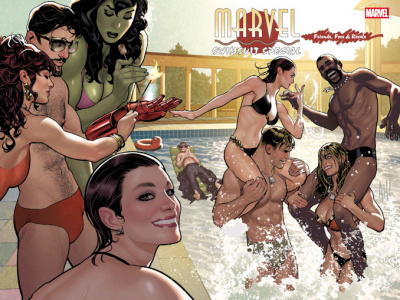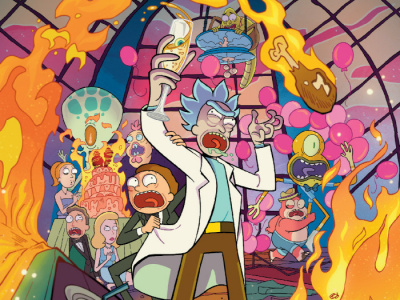At the San Diego Comic-Con International in July, we sat down with DC Comics President and Publisher Paul Levitz, joined by Vice President Direct Sales Bob Wayne, and conducted this extensive three-part interview. In Part I, we talked about the state of the comic market in comic stores, book stores, and the newsstand channel (see 'Interview with DC Prez Paul Levitz, Part I'). In Part II, we talked about the impact of movies on comic sales, and about DC's aggressive move into importing European material into the U.S. this year (see 'Interview with DC Prez Paul Levitz, Part II'). In Part III, we talk about how comic stores can share in the growth in book format comic sales, and about the challenges facing the market.
There's been a feeling in some circles in the direct market that the expansion into bookstores by comic publishers is in a sense leaving them behind. What would you tell a direct market retailer who feels that way about the situation, and how they could take advantage of this broader interest?
Wayne: For our product line, we still sell more of our book formats through the comic shop retailers than the bookstores and the growth curve for comic shops has been a very consistent curve with the book store curve, so I think they are taking advantage of it. A lot of the product we produce is probably more suitable for the comic shop market than the bookstore market.
Levitz: I think the opportunity for the retailers (and I think it's an enormous opportunity for the guys who have not yet done it, and that's a significant number of retailers) is that number one, these are net new customers. The people who are buying these books behave differently, want to behave differently in the long run, and are not intrinsically against going to a comic shop, depending on where the comic shop is, how convenient it is, what the selection is. They're either buying in a book store because they happened to see it in a book store, or they're buying it online because that's the easiest way to get it, or they're buying in a comic shop because the comic shop is convenient to them and is a friendly place to do business and get their fix happily. It's not diluted much of the business. There are a couple of weird spots where some people will wait for the trade paperback, but for the most part we don't see it taking away value. Bob might have a better sense than I do of what proportion of comic shops are doing a good job with their book format line. There's a meaningful percentage that are not great at it yet.
I would further add that it ought to be managed properly to be a very good contributor to a comic shop. You don't have to take inventory risks, certainly not from publishers like us who maintain a good inventory. Even if you do not buy the 700 SKUs from us, but took the top 100 SKUs from us, you would be taking in and maintaining a list of titles that turn at a great pace. You have no risk of unsold inventory because of the historic turns of the titles. And you have very little inventory carrying costs because you can be ordering them as you sell them, whether it's the old bookstore method (put a little card in the back, and reorder every time you get the card), or any more sophisticated system you can use than that. Comic shops are making a hell of a lot of money selling Watchmen, Sandman, Preacher, TransMet, and I think that will continue.
There have been a lot of good things happening in the comic market the last couple of years after a long drought. What do you see as the biggest challenge facing the industry right now?
Levitz: You continue to have the challenge of being understored. That affects you in the core market--it's still hard to find a comic shop in a lot of the country. It's hard for the guys to get the investment capital to build a bigger store in a better location or build additional stores, so I don't see an immediate answer on the horizon. But we know from our prior experiences in our prior lives that there's room in the marketplace for another 1,000 to 2,000 comic shops in the right places that wouldn't be taking a hell of a lot of sales away from any existing shops, and that's a pretty big opportunity.
Wayne: Some of those customers who live in the understored areas are disproportionately comic shop customers, but they're buying them in a chain bookstore, and they're doing a channel migration because it's just substantially easier for them because there's not a store that's nearby any more.
There's always going to be some frustration. I go back to when Donning was first collecting the Elfquest books. It seemed like each new book always made it faster into mass then it did into any of the other distribution channels. Inevitably, I was behind the counter the day it came out, and someone would come in waving it to me, showing what they had just found at the local mall store. There's certainly a very strong emotional response to that. I can still remember it and it's been 24 years since having somebody come in and wave something in a Waldenbooks bag. I was behind the counter thinking, 'That's my customer. I see them twice a week. How could this have happened to me?' That's a tough thing to get over. It was tough to get over then, it's tough to get over now.
You have to manage the way a product moves through the distribution channels, manage what product is available in each channel, and make sure that your core customers get the full breadth of your line. Working with Diamond we've had very few problems in that regard, and none of it intentional. If it turns out that a Sandman volume moves faster for a three week period than it's moved in the last six months, that's a good problem in comparison to if it had moved slower than it ever moved, and we've never had that problem with Sandman.
Levitz: The other related element is the growth challenge. As the book format becomes more important, that has a challenge for this marketplace. The low cost-of-entry barrier that has allowed a bunch of vigorous, interesting small presses to form in the past couple of decades doesn't work for the trade paperback nearly as well (the carrying of the inventory, the costs to reach the additional forms of distribution, the difficulty of marketing those titles, keeping them for the long term), so we have to find ways as a larger community for that business paradigm to be solved for the smaller presses so they can grow into the means of doing it, or change the paradigm in some form or fashion, or we'll lose some of the vigor that we've gotten from that creativity.
Wayne: At the same time, the flip side of that is the challenge of opening up a new comic shop in this environment. It used to be perfectly reasonable to strip-mine your own collection, get an account with somebody, start carrying new periodicals and you fill the space. You get a couple weeks' worth of stuff in before you open the door, you've got a couple of new comics, you've got a couple of back issues. The expectation for most consumers is that you're going to have Watchmen, you're going to have all the Sandmans. Once you get it amortized, you can get it built to where you're just turning the stuff, but it's the initial investment that's a problem in capitalizing a new store.
Levitz: From another perspective, it is incredibly difficult to place an order as a retailer for a list of three, four hundred titles that came out in a month when you're first opening the business and you have no experience. Now you open a store and instead of placing the order for three months that way in advance, you have that -- I don't know what proportion of the titles in print DC represents, but certainly...less than a quarter or a fifth?
There are thousands of graphic novels in print.
Levitz: So you're making an additional judgment on a list of five thousand things. Brain exploding -- danger, danger, danger.







